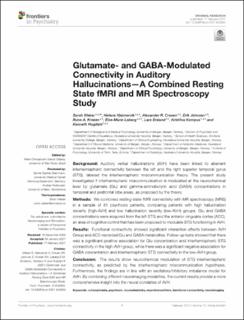| dc.contributor.author | Weber, Sarah | |
| dc.contributor.author | Hjelmervik, Helene | |
| dc.contributor.author | Craven, Alexander R. | |
| dc.contributor.author | Johnsen, Erik | |
| dc.contributor.author | Kroken, Rune Andreas | |
| dc.contributor.author | Løberg, Else-Marie | |
| dc.contributor.author | Ersland, Lars | |
| dc.contributor.author | Kompus, Kristiina | |
| dc.contributor.author | Hugdahl, Kenneth | |
| dc.date.accessioned | 2021-08-10T12:54:01Z | |
| dc.date.available | 2021-08-10T12:54:01Z | |
| dc.date.created | 2021-02-17T11:28:35Z | |
| dc.date.issued | 2021 | |
| dc.identifier.issn | 1664-0640 | |
| dc.identifier.uri | https://hdl.handle.net/11250/2767210 | |
| dc.description.abstract | Background: Auditory verbal hallucinations (AVH) have been linked to aberrant interhemispheric connectivity between the left and the right superior temporal gyrus (STG), labeled the interhemispheric miscommunication theory. The present study investigated if interhemispheric miscommunication is modulated at the neurochemical level by glutamate (Glu) and gamma-aminobutyric acid (GABA) concentrations in temporal and prefrontal lobe areas, as proposed by the theory.
Methods: We combined resting-state fMRI connectivity with MR spectroscopy (MRS) in a sample of 81 psychosis patients, comparing patients with high hallucination severity (high-AVH) and low hallucination severity (low-AVH) groups. Glu and GABA concentrations were acquired from the left STG and the anterior cingulate cortex (ACC), an area of cognitive control that has been proposed to modulate STG functioning in AVH.
Results: Functional connectivity showed significant interaction effects between AVH Group and ACC-recorded Glu and GABA metabolites. Follow-up tests showed that there was a significant positive association for Glu concentration and interhemispheric STG connectivity in the high-AVH group, while there was a significant negative association for GABA concentration and interhemispheric STG connectivity in the low-AVH group.
Conclusion: The results show neurochemical modulation of STG interhemispheric connectivity, as predicted by the interhemispheric miscommunication hypothesis. Furthermore, the findings are in line with an excitatory/inhibitory imbalance model for AVH. By combining different neuroimaging modalities, the current results provide a more comprehensive insight into the neural correlates of AVH. | en_US |
| dc.language.iso | eng | en_US |
| dc.publisher | Frontiers | en_US |
| dc.rights | Navngivelse 4.0 Internasjonal | * |
| dc.rights.uri | http://creativecommons.org/licenses/by/4.0/deed.no | * |
| dc.title | Glutamate- and GABA-Modulated Connectivity in Auditory Hallucinations—A Combined Resting State fMRI and MR Spectroscopy Study | en_US |
| dc.type | Journal article | en_US |
| dc.type | Peer reviewed | en_US |
| dc.description.version | publishedVersion | en_US |
| dc.rights.holder | Copyright 2021 The Authors | en_US |
| dc.source.articlenumber | 643564 | en_US |
| cristin.ispublished | true | |
| cristin.fulltext | original | |
| cristin.qualitycode | 1 | |
| dc.identifier.doi | 10.3389/fpsyt.2021.643564 | |
| dc.identifier.cristin | 1890785 | |
| dc.source.journal | Frontiers in Psychiatry | en_US |
| dc.identifier.citation | Frontiers in Psychiatry. 2021, 12, 643564 | en_US |
| dc.source.volume | 12 | en_US |

